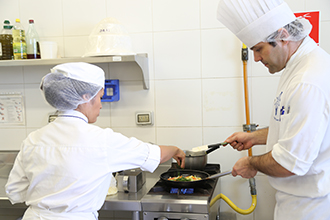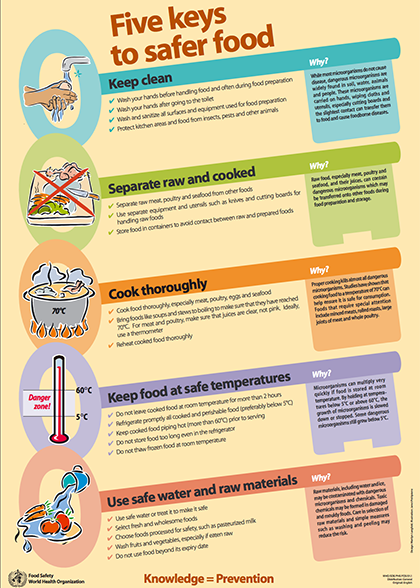Food safety is everyone’s business [1]

The first ever celebration of the United Nations World Food Safety Day, to be marked globally on 7 June, aimed to strengthen efforts to ensure that the food we eat is safe. Every year, nearly one in ten people in the world (an estimated 600 million people) fall ill and 420,000 die after eating food contaminated by bacteria, viruses, parasites or chemical substances.Unsafe food also hinders development in many low- and middle-income economies, which lose around US$ 95 billion in productivity associated with illness, disability, and premature death suffered by workers.
An estimated 77 million people in the Americas suffer an episode of foodborne illness each year, half of them children under 5. Available data indicates that foodborne diseases generate $700,000 to $19 million in annual health costs in Caribbean countries and more than $77 million in the United States.
World Food Safety Day 2019’s theme was that food safety is everyone’s business. Food safety contributes to food security, human health, economic prosperity, agriculture, market access, tourism and sustainable development.
The UN has designated two of its agencies, the Food and Agriculture Organization (FAO) and the World Health Organization (WHO) to lead efforts in promoting food safety around the world.
FAO and WHO are joining forces to assist countries to prevent, manage and respond to risks along the food supply chain, working with food producers and vendors, regulatory authorities and civil society stakeholders, whether the food is domestically produced or imported.
In Latin America and the Caribbean, the Pan American Health Organization (PAHO), through its Food Safety Regional Program, coordinated by the Pan American Center for Foot and Mouth Disease and Veterinary Public Health (PANAFTOSA), is working with countries to strengthen their national food safety and surveillance systems. Some of the areas of focus include strengthening risk-based inspection and control systems to prevent national and international incidents due to contaminated food and enhancing laboratory capacities needed to protect food safety. “Whether you are a farmer, farm supplier, food processor, transporter, marketer or consumer, food safety is your business,” FAO Director-General José Graziano da Silva said. “There is no food security without food safety,” he said.
“Unsafe food kills an estimated 420,000 people every year. These deaths are entirely preventable,” said Dr Tedros Adhanom Ghebreyesus, WHO Director-General. “World Food Safety Day is a unique opportunity to raise awareness about the dangers of unsafe food with governments, producers, handlers and consumers. From farm to plate, we all have a role to play in making food safe.”
Investing in sustainable food systems pays off
FAO and WHO underline the importance of everyone’s access to safe, nutritious and sufficient food, and that safe food is critical to promoting health and ending hunger, two of the primary aims of the Sustainable Development Goals.
Safe food allows for suitable intake of nutrients and contributes to a healthy life. Safe food production improves sustainability by enabling market access and productivity, which drives economic development and poverty alleviation, especially in rural areas. Investment in consumer food safety education has the potential to reduce foodborne disease and return savings of up to $10 for each dollar invested.
About World Food Safety Day
Activities around the world for World Food Safety Day aim to inspire action to help prevent, detect and manage foodborne health risks.
The right actions along the food supply chain, from farmers to consumers, as well as good governance and regulations, are essential to food safety.
FAO and WHO have created a new guide to show how everyone can get involved. The guide includes five steps to make a sustained difference to food safety:
-
Ensure it’s safe. Governments must ensure safe and nutritious food for all.
-
Grow it safe. Agriculture and food producers need to adopt good practices.
-
Keep it safe. Business operators must make sure food is safely transported, stored and prepared.
-
Check it’s safe. Consumers need access to timely, clear and reliable information about the nutritional and disease risks associated with their food choices.
-
Team up for safety. Governments, regional economic bodies, UN organizations, development agencies, trade organizations, consumer and producer groups, academic and research institutions and private sector entities must work together on food safety issues.
Starting in 2019, every 7 June will be a time to highlight the benefits of safe food. World Food Safety Day was adopted by the United Nations General Assembly in December 2018. The process was initiated in 2016 by Costa Rica through the Codex Alimentarius Commission, which is managed by FAO and WHO.
 Five keys to safer food in the home and in food establishments
Five keys to safer food in the home and in food establishments
Food can become contaminated at any point in the food chain.In the home and in food establishments, proper handling of food can be assured by implement PAHO/WHO’s 5 key recommendations:
-
Use safe water and ingredients
-
Keep your hands, utensils, and surfaces clean
-
Cook food thoroughly
-
Keep food at safe temperatures
-
Separate raw from cooked food
Food Safety Facts
-
An estimated 600 million people – almost 1 in 10 people in the world – fall ill after eating contaminated food and 420 000 die every year.
-
An estimated 77 million people in the Americas suffer an episode of foodborne illness each year, half of them children under 5.
-
Children aged under 5 carry 40% of the foodborne disease burden, with 125 000 deaths every year.
-
Foodborne illnesses are caused by bacteria, viruses, parasites or chemical substances entering the body through contaminated food or water.
-
Foodborne diseases impede socioeconomic development by straining health care systems and harming national economies, tourism and trade.
-
The value of trade in food is US$ 1.6 trillion, which is approximately 10% of total annual trade globally.
-
Recent estimates indicate that the impact of unsafe food costs low- and middle-income economies around US$ 95 billion in lost productivity each year.
-
Available data indicates that foodborne diseases generate $700,000 to $19 million in annual health costs in Caribbean countries and more than $77 million in the United States.
-
Improving hygiene practices in the food and agricultural sectors helps to reduce the emergence and spread of antimicrobial resistance along the food chain and in the environment.
Related Links
-
Follow the conversation on Twitter #WorldFoodSafetyDay







